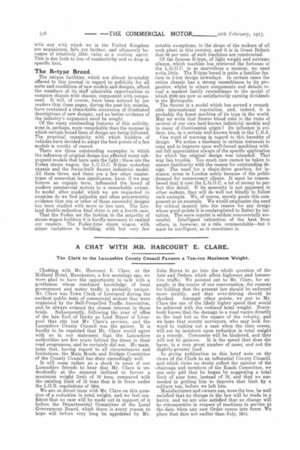A CHAT WITH MR. HARCOURT E. CLARE.
Page 2

If you've noticed an error in this article please click here to report it so we can fix it.
The Clerk to the Lancashire County Council Favours a Ten-ton Maximum Weight.
Chatting with Mr. Harcourt E. Clare, at the Midland Hotel, Manchester, a few mornings ago, we were glad to have the opportunity to talk with a gentleman whose combined knowledge of local government and motor traffic is probably unique. Mr. Clare was Town Clerk of Liverpool during the earliest public tests of commercial motors that were organized by the Self-Propelled Traffic Association, and he always evinced the closest interest in those
trials. Subsequently, following the year of office of the late Earl of Derby as Lord Mayor of Liverpool that city lost Mr. Clare's services, and the Lancashire County Council was the gainer. It is hardly to be expected that Mr. Clare would agree with us in our statement that the Lancashire authorities are five years behind the times in their road programme, and he certainly did not. He maintains that, having regard to all circumstances and limitations, the Main Roads and Bridges Committee of the County Council has done exceedingly well. It will come rather as a shock to some of our Lancashire friends to hear that Mr. Clare is undoubtedly at the moment inclined to favour a maximum weight limit of 10 tons, compared with the existing limit of 12 tons that is in force under the L.G.B. regulations of 1904.
We are at direct issue with Mr. Clare on this question of a reduction in total weight, and we feel confident that no case will be made out in support of it before the Departmental Committee of the Local Government Board, which there is every reason to hope will before very long be appointed by Mr.
John Burns to go into the whole question of the Acts and Orders which affect highways and locomotive traffic. We pointed out to Mr. Clare, for example, in the course of our conversation, the reasons for holding that the present law should be enforced more strictly, and that over-driving should be checked. Amongst other points, we put to Mr. Mare the one of the likely higher speed that would be achieved with the reduced total weight. Everybody knows that the damage to a road varies directly as the load but as the square of the velocity, and we hope that county surveyors, who may look forward to making out a case when the time comes, will not be insistent upon reduction in total weight as a remedy. Commerce will be hindered, and they will not be gainers. It is the speed that does the harm, in a very great number of cases, and not the slightly-greater load. In giving publication to this brief note on the views of the Clerk to an influential County. Council, and which views no doubt reflect the opinion of the chairman and members of the Roads Committee, we can only add that he began by suggesting a total limit of nine tons, instead of 12, and that we succeeded in getting him to improve that limit by a solitary ton, before we left him.
Manufacturers and owners can, none the less, be well satisfied that no change in the law will be made in a hurry, and we are also satisfied that no change will be retrospective in respect of machines in service at the date when any new Order comes into force. We place that date not earlier than July, 1914.
































